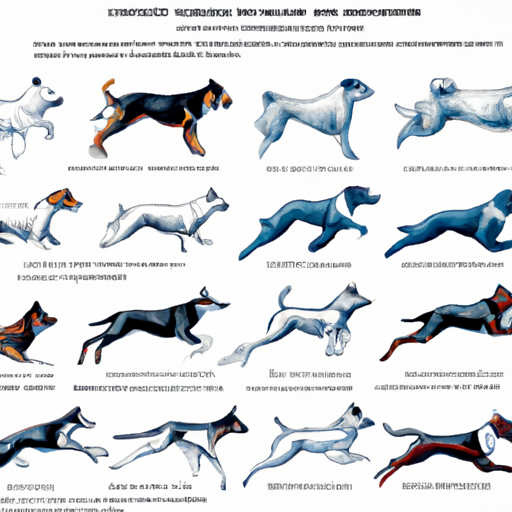If you’ve ever watched a dog in full stride, you might have marveled at the graceful, effortless way they move. But how do dogs run? What are the mechanics behind their powerful yet fluid movement? In this comprehensive guide, we’ll explore the fascinating world of canine locomotion, shedding light on the unique ways dogs run and how it contributes to their health and wellbeing.
Table of Contents:
1. Understanding Canine Locomotion
2. The Four Gaits of Dogs
3. The Anatomy of a Dog in Motion
4. How Speed Affects A Dog’s Gait
5. The Role of Breed in Dogs’ Running Style
6. Frequently Asked Questions
Key Takeaways:
– Dogs have four main types of gaits: walk, trot, canter, and gallop.
– The breed of a dog significantly affects its running style and speed.
– The anatomy of a dog plays a key role in its locomotion.
– Regular exercise, including running, is crucial for a dog’s health.
Understanding Canine Locomotion
Canine locomotion is a complex process that involves different body parts working in harmony. It’s not just about the legs. The spine, tail, and even the head play crucial roles in a dog’s movement. You can learn more about the intricacies of canine locomotion in this study.
To understand how your furry friend runs, let’s first understand the four types of gaits that dogs use.
The Four Gaits of Dogs
- Walk: This is the slowest and most energy-efficient gait. Dogs move one foot at a time, always having at least two, and usually three, on the ground.
- Trot: This is the dog’s equivalent of a jog. Dogs move diagonally opposite legs in unison, keeping two feet on the ground at all times.
- Canter: This is a moderately fast gait, where dogs move their legs in a 2-beat sequence. It’s less balanced than a trot but faster.
- Gallop: This is the fastest gait, where dogs use a 4-beat sequence. At certain points, all four paws are off the ground.
The Anatomy of a Dog in Motion
The anatomy of a dog significantly influences its running style. For instance, a dog’s flexible spine allows it to stretch out while running, covering more ground per stride. The tail also plays a crucial role, acting as a counterbalance during turns. This article from One Top Dog provides a detailed look at a dog’s anatomy and how it influences movement.
How Speed Affects A Dog’s Gait
As dogs increase their speed, their gait changes from a walk to a trot, then a canter, and finally, a gallop. This transition allows them to run efficiently without wasting energy. For more on how speed impacts a dog’s gait, check out this post.
The Role of Breed in Dogs’ Running Style
The breed of a dog can significantly impact how it runs. For instance, Greyhounds, built for speed, have a double suspension gallop, where they have two periods of suspension in each stride. On the other hand, breeds like Bulldogs, with their broad, compact bodies, are not designed for speed and thus have a different running style. To learn more about how breed affects a dog’s running style, visit this page.
Frequently Asked Questions
-
Why do dogs move their legs in unison when they run?
Dogs move their legs in unison when they run to maintain balance and efficiency. It’s a natural locomotive pattern that allows them to cover more ground quickly and smoothly. -
Do all dogs run the same way?
No, different breeds have different running styles. Factors like body size, leg length, and overall build significantly influence a dog’s running style. -
Is running good for dogs?
Yes, regular exercise, including running, is crucial for a dog’s physical and mental health. However, the amount and intensity of exercise should be appropriate for the dog’s age, breed, and health status.
In conclusion, understanding how dogs run isn’t just interesting; it’s also beneficial for their caregivers. By recognizing your dog’s natural running style, you can ensure they get the right type and amount of exercise, contributing to their overall health and happiness.



